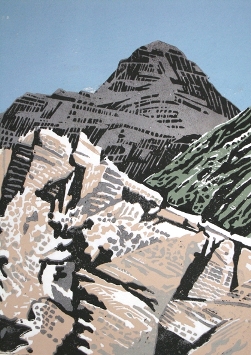
Jean’s lino cuts have a rugged yet sensuous quality, well suited to mountainous landscapes such as those of Westmorland where she now lives. I asked Jean about her connection with her native landscape and found her connection with it was more than purely artistic.
“When I moved back north, I joined the Westmorland Geological Society and became southern co-ordinator on Cumbria RIGS, for whom I produced several field guides” she told me. “I have recently become interested in lichens and have an exhibition in the local library of lichens in the parish churchyard.”
Lino cutting is a pretty arduous technique – from wielding the knife to making the prints by hand. I asked whether she had explored other media, and what made lino cutting her particular medium of choice.
“I prefer to paint and draw in wild places with interesting geology. In cutting lino I have to select and simplify. This gives a unity to the rock, brings out the various features that are impossible in watercolour or oils.”